– (Reading Time: 35 min Approx.)
NOTE TO READER: Read philosophically
RECAP: [Walking the footsteps of history the living dead explored every nook and corner of The Indian Botanic Garden. The trip became more exciting as Sir Charles Stuart joined their adventure. Following his guidance, the group decided to head towards the Indian Museum.]
“Did you hear that?” – I whispered addressing all. “What are you talking about?” – asked Colonel Kyd.
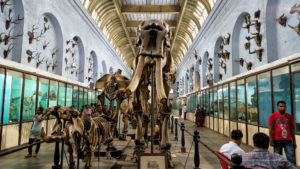
“Don’t you hear a soft growling sound?” – I asked. “It is coming from that room, I think.” – Sister Elizabeth said. “It hasn’t been 5 seconds we stepped inside and already terrifying things have started to happen. I told you we shouldn’t have come here this late.” – Charlotte exclaimed in a frightened voice. Well, it might seem a bit awkward, but Charlotte was scared to come here. She kept ranting all the way from Victoria memorial to Indian museum. Don’t laugh but I think she is scared of all the dead animals around here (Specially that mummy).
Captain Cooke is bravest of us all. He said – “Fear not Aye! Follow me to that room, all of you!” We all followed him and as we reached close to the room; we discovered it is indeed the room of the mummy. And a growling sound was coming from inside.
“Let’s just turn back! Listen to me folks!” – Charlotte again started to panic. William Jones said – “This place was Founded in 1814 at the cradle of my Asiatic Society of Bengal. Nothing can harm or stop us! Come on, Cooke let’s go inside!”
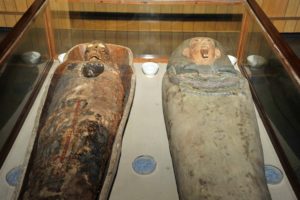 As we all stepped inside with mixed feelings of anxiety and suspicion, and turned on the light…Well, it was indeed the mummy. But it was snoring really loud. Due to the lights he woke up and started crying in grief. “Why can’t you all just spare me a goodnight sleep?” – the mummy said in a sobbing manner.
As we all stepped inside with mixed feelings of anxiety and suspicion, and turned on the light…Well, it was indeed the mummy. But it was snoring really loud. Due to the lights he woke up and started crying in grief. “Why can’t you all just spare me a goodnight sleep?” – the mummy said in a sobbing manner.
We were all shocked as we weren’t expecting him to burst in tears. Charlotte somehow calmed herself down and asked softly – “Please don’t cry. What’s wrong?”. In the same sobbing manner, the mummy said – “I hardly get to sleep during the day. Unknown, unwelcomed people just enter here and eye all over my body. They even mock my half naked condition. I should have worn my cloths before being mummified.”
Captain Cooke started laughing heartily and hearing that the mummy started crying out loud. We didn’t want to wake up the security, so we all rushed near him to make him stop. After many failed attempts when we couldn’t, sister Elizabeth came forward and sang him the lullabies that she sings for little Henry. And as soon as the mummy went back to sleep, we all turned off the light and left the room at our earliest.
“What a menace, Aye! Never going back to that wining piece of sheet (read between the lines) again.” – exclaimed Captain Cooke with a sound of relief. As I said, Captain Cooke can be really sarcastic sometimes.
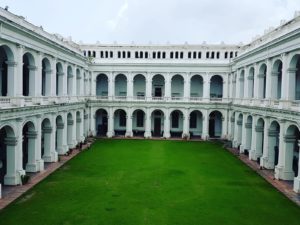
To appreciate the history of the origin and growth of the Indian Museum; we are to travel back to the last quarter of the 18th century when Sir William Jones devoted his life to the service of India – and founded the Asiatic Society.
The role of the Asiatic Society was to form a learning centre for the development of art and culture pertaining to the socio-cultural activities, entertaining people, disseminating knowledge and preserving the cultural as well as natural heritage of mankind for posterity within the geographical limits of Asia.
“I beg your pardon for showing up so late” – Charles Stuart said. “What took you so long?” – asked Sir Jones. “Actually, I was having a conversation with Walter Landor Dickens (son of English novelist Charles Dickens). He gave me some remarkable insight on the Bhowanipore war cemetery as he stayed there till 1987 before moving in with us. I will share that with you all some other time. A very happy death day, Rose.” – Sir Stuart said to me.
Sir Stuart is a very kind man. He despises the torturous behaviour and deeds the Britishers committed on you all. And we all couldn’t agree more with him. When you enter the afterlife, you realise more of your wrong doings prominently. We all know it won’t be enough to apologise for our vicious deeds but not all of us wanted to be your enemy. Rather we were glad to know your culture and heritage from this close.
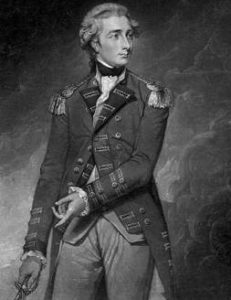 Charles Stuart (1758 – 1828) was an officer in the East India Company Army and is well known for being one of the few British officers to embrace Hindu culture while stationed here, earning the nickname Hindoo Stuart. He also wrote books and several newspaper articles extolling Hindu culture and tradition and urging its adoption by Europeans settled in India and deploring the attitudes and activities of the Utilitarian and missionaries who deprecated Indian culture.
Charles Stuart (1758 – 1828) was an officer in the East India Company Army and is well known for being one of the few British officers to embrace Hindu culture while stationed here, earning the nickname Hindoo Stuart. He also wrote books and several newspaper articles extolling Hindu culture and tradition and urging its adoption by Europeans settled in India and deploring the attitudes and activities of the Utilitarian and missionaries who deprecated Indian culture.
“We have all said our part. It is your turn now Stuart to take us on a tour of the history of 19th century Calcutta.” – said Colonel Robert Kyd.
We all sat on the green lawn of Indian museum as Charles Stuart began his story.
In the 19th and 20th centuries, with the advent of British imperialism, many wealthy and influential zamindars were bestowed with princely and royal titles such as Maharaja (Great King), Raja (King) and Nawab.
During Mughal Era the Zamindars were not proprietors. They used to engage in wars and used to plunder neighbouring kings. So, they never looked after the improvements in their land. The East India Company under Lord Cornwallis (the same Cornwallis who had surrendered at Yorktown, USA in 1781), realising this, brought in the Permanent Settlement Act in 1793 with the Zamindars and made them proprietors of their land in return for a fixed annual rent. The Zamindars of Bengal were influential in the development of Bengal. They played pivotal part during the Indian Rebellion of 1857 as well.
Historically, Calcutta was the centre of activity in the early stages of the national movement of independence. Exactly a hundred years after the fall of Bengal in the Battle of Plassey, Calcutta saw the beginning of what is often called the First Independence Movement of India. It is also just as often as not referred to as a War of Independence, and as one historian put it, “The so called First National War of Independence was neither First, nor National, nor a War of Independence”.
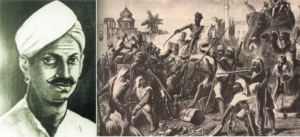 In the suburbs of Calcutta, at the Barrackpore military barracks, sepoy Mangal Pandey sparked off a huge revolt that shook the foundations of the British Empire. This movement is sometimes also called the Indian Mutiny, although recent evidence goes against using this name and suggests “The Revolt of 1857” as a better and less controversial choice.
In the suburbs of Calcutta, at the Barrackpore military barracks, sepoy Mangal Pandey sparked off a huge revolt that shook the foundations of the British Empire. This movement is sometimes also called the Indian Mutiny, although recent evidence goes against using this name and suggests “The Revolt of 1857” as a better and less controversial choice.
Mangal Pandey (19 July 1827 – 8 April 1857) was an Indian soldier who played a key part in the events immediately preceding the outbreak of the Indian rebellion of 1857. He was a sepoy (sipahi) in the 34th Bengal Native Infantry (BNI) regiment of the British East India Company. Later, in 1984, the Indian government issued a postage stamp to remember him. The Bengal Native infantry was the infamous regiment that is credited with starting the Bengal Mutiny or the Revolt of 1857 (the one because of rumours that gun cartridges were made of cow and pig skin). The aftermath of this Mutiny was the reorganisation of the regiments, basically abolished them and made new ones so that people forget and do not have ethnic connect with each other. And that is why Indian Army never had a proper Bengal Regiment like other states have after the revolt.
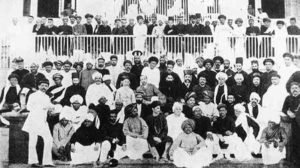 The Indian Rebellion of 1857 was ultimately unsuccessful, but it still proved to be an important watershed in the history of Indian-British relations and marked the beginning of the Indian Independence Movement which though started taking actual shape three decades later.
The Indian Rebellion of 1857 was ultimately unsuccessful, but it still proved to be an important watershed in the history of Indian-British relations and marked the beginning of the Indian Independence Movement which though started taking actual shape three decades later.
The decades following the Rebellion were a period of growing political awareness, the manifestation of Indian public opinion and the emergence of Indian leadership at both national and provincial levels. Dadabhai Naoroji formed the East India Association in 1867 and Surendranath Banerjee founded the Indian National Association in 1876. The objectives of this Association were “promoting by every legitimate means the political, intellectual and material advancement of the people”. The Association attracted educated Indians and civic leaders from all parts of the country and became an important forum for India’s aspirations for independence. It later merged with the Indian National Congress.
The Indian National Congress conducted its first session in Bombay from 28–31 December 1885 at the initiative of retired Civil Service officer Allan Octavian Hume. In 1883, Hume had outlined his idea for a body representing Indian interests in an open letter to graduates of the University of Calcutta. Mahatma Gandhi returned from South Africa in 1915. With the help of the moderate group led by Ghokhale, Gandhi became president of Congress. After the First World War, the party became associated with Gandhi, who remained its unofficial spiritual leader and icon.
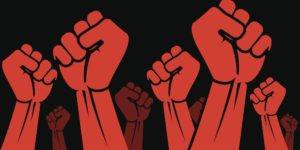 One can never deny the amount of courage and brevity your countrymen showed for the sake of this country. “I feel unfortunate for not getting the chance to meet such great social reformers of Bengal.” – Vivian heaved a sigh of grief.
One can never deny the amount of courage and brevity your countrymen showed for the sake of this country. “I feel unfortunate for not getting the chance to meet such great social reformers of Bengal.” – Vivian heaved a sigh of grief.
The rise of Indian National Association subsequently gave birth to other societies based on nationalist or religious thoughts, like the Hindu Mela. Its primary objective was to awaken a sense of national pride among the city-dwellers through indigenous handmade products rather than imported British-made products. It included the display of swadeshi wrestling, swadeshi art and recital and performances of swadeshi poetry and songs.
“Taking in account the nationalistic movements, one cannot deny the contribution of Brahmo Samaj. It began as a monotheistic reformist movement of the Hindu religion that appeared during the Bengal Renaissance. I strongly believe that it was Brahmo Samaj that began the Bengal Renaissance of the 19th century pioneering all religious, social and educational advance of the Hindu community at that time.” – added Henry Louis Vivian Derozio. His respect towards the cultural, social and historical heritage of Calcutta is highly commendable. He makes me proud for being a part of this city’s history.
“What about Thomas Babington Macaulay’s letter?” – asked Robert Kyd addressing Charles Stuart. “What about it?” – Sir Stuart replied. “I heard he wrote a letter to the British Parliament which still arises controversy on the historical context of Indian independence. Though many pointed fingers on the letter’s authenticity.” – added Colonel Kyd.
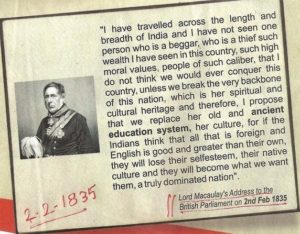
We had no idea about this, so we all looked at Sir Stuart with confused eyes.
“Well, I am not quite sure as well. A journal published a piece claiming that Macaulay said he took a tour of India and realised that there wasn’t single beggar or thief in this country. Which predominantly proclaims the kind of financially solvent lifestyle the Indians had. So, he pointed out on the letter that if the Britishers have to colonise India then they must break their biggest strength that is Indian spirituality and cultural heritage.” – said Sir Stuart.
“How did he propose to do that?” – asked sister Charlotte.
“Well, he said that the only way to conquer this country will be to replace their education system and culture with western approach of lifestyle. It was very mean though to destroy a country’s existence by replacing their own culture and ideologies.” – though, till date the legitimacy of the letter is questionable, said Sir Stuart.

Education has always been given great prominence in Indian society since the times of the Vedic civilization, with gurukul and ashrams being the centres of learning. And with evolving times, a large number of centres of learning were established across ancient India of which Takshashila and Nalanda are the most famous ones known today. “Even if you notice the history of Indian Education you will see when the first university of Europe came to existence in 1088 at Bologna, Italy and that of England in 1096 at Oxford, England, the biggest universities of India – Takshila (founded in around 1000 BCE and destroyed by White Huns in 499 AD), Nalanda (5th Century to Destroyed by Bakhtiyar Khilji in 1193 AD) and Vikramshila (8th Century to Destroyed by Bakhtiyar Khilji in 1193 AD) was being destroyed in India”- Derozio added.
“That’s true! Taking that in account one can’t easily scratch out that letter. Also, if you read the words of the ancient philosopher and economist Chankya this concept of cultural slavery mentioned on the letter can be understood prominently.” – Charles Stuart replied.
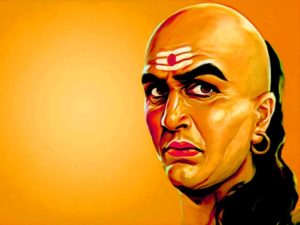 According to Chankya, (one of the greatest scholars and teacher of Politics and Economics world ever had) – Cultural slavery can lead to the destruction of an entire nation. A nation is not defeated till it can safeguard its culture and values. A nation torn into pieces in the name of Caste and Religion can never protect itself from the invaders. If the conquerors wish to spread their roots, then they have to attack the Indian culture, which binds Indians. And the invaders will, if all the Indians failed to be careful. Letting go of one’s cultural heritage will lead to the downfall of the nation, undoubtedly. He also highlighted the fact that if we consider the history, we can easily see how the colonized nations have submitted and accepted the culture of the conquerors due to the helpless situation. Hence, if India didn’t wake up from its stupor soon, if they don’t fight back unitedly, then freeing themselves from the bondage of other religion’s slavery will be next to difficult.
According to Chankya, (one of the greatest scholars and teacher of Politics and Economics world ever had) – Cultural slavery can lead to the destruction of an entire nation. A nation is not defeated till it can safeguard its culture and values. A nation torn into pieces in the name of Caste and Religion can never protect itself from the invaders. If the conquerors wish to spread their roots, then they have to attack the Indian culture, which binds Indians. And the invaders will, if all the Indians failed to be careful. Letting go of one’s cultural heritage will lead to the downfall of the nation, undoubtedly. He also highlighted the fact that if we consider the history, we can easily see how the colonized nations have submitted and accepted the culture of the conquerors due to the helpless situation. Hence, if India didn’t wake up from its stupor soon, if they don’t fight back unitedly, then freeing themselves from the bondage of other religion’s slavery will be next to difficult.
 One thing was evident is that Britishers did fear the cultural and spiritual strength of this country. And why wouldn’t they? When a country had social reformers like Ramakrishna, Vivekananda, Rishi Aurobindo, Dr. Atmaram Pandurang, Mahadev Govind Ranade, Dayanand Saraswati, Annie Beasant; it is evident to fear their greatness of morale and character.
One thing was evident is that Britishers did fear the cultural and spiritual strength of this country. And why wouldn’t they? When a country had social reformers like Ramakrishna, Vivekananda, Rishi Aurobindo, Dr. Atmaram Pandurang, Mahadev Govind Ranade, Dayanand Saraswati, Annie Beasant; it is evident to fear their greatness of morale and character.
Revolutionary organisations, on the other hand, like the Jugantar and the Anushilan Samiti were formed with the goal of using force against the British rulers. Among early nationalist leaders, the most prominent were Sri Aurobindo. He was an Indian philosopher, yogi, guru, poet, and nationalist. He joined the Indian movement for independence from British rule, for a while was one of its influential leaders and then became a spiritual reformer, introducing his visions on human progress and spiritual evolution.
Subhas Chandra Bose was elected as the President of the Indian National Congress (INC) in 1938. He sought re-election to the Presidentship of the party in 1939. Gandhi was supporting Pattabhi Sitaramayya for the Presidentship. However, due to the support given by radical elements within the party, Bose was re-elected as the president of the INC. Gandhi was not happy with his re-election and said that the defeat of Pattabhi Sitaramayya was his own defeat. Pained by Gandhi’s agonies, 13 members of the Congress Working Committee resigned. At this time, several delegates who had supported Bose began supporting Gandhi. It was increasingly becoming difficult for Bose to work as the President and hence he resigned from the Presidentship in 1939 and left Congress.
 The Elgin Road residence of Subhas Chandra Bose in Calcutta was the place from where he escaped the British to reach Germany during the Second World War. He was the founder of Azad Hind Fauj in Germany and co-founder of the Indian National Army in South East Asia and the head of state of the Arzi Hukumate Azad Hind, formed to counter and combat the British Raj in India. Renamed Netaji by poet laureate Rabindranath Tagore, he is regarded by many (including the British Prime Minister Clement Attlee) as perhaps the actual reason of India’s Independence and the most prominent and influential freedom fighter in Indian history and is venerated in many Bengali households even today. We must try to understand this man if we need to understand India’s Independence from British.
The Elgin Road residence of Subhas Chandra Bose in Calcutta was the place from where he escaped the British to reach Germany during the Second World War. He was the founder of Azad Hind Fauj in Germany and co-founder of the Indian National Army in South East Asia and the head of state of the Arzi Hukumate Azad Hind, formed to counter and combat the British Raj in India. Renamed Netaji by poet laureate Rabindranath Tagore, he is regarded by many (including the British Prime Minister Clement Attlee) as perhaps the actual reason of India’s Independence and the most prominent and influential freedom fighter in Indian history and is venerated in many Bengali households even today. We must try to understand this man if we need to understand India’s Independence from British.
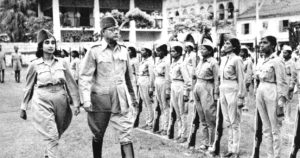
“A man, born in an upper middle-class / wealthy established Bengali Family, got the best of the education, went to England, obtained the 4th Rank in the ICS Examination and then let it go, joined the freedom struggle of India under the mentorship of Deshbandhu Chittaranjan Das, was the strongest leader with greatest fan following in the history of India, worked in Congress for about 20 years and became the Congress President twice (second time by winning election against the support of Gandhi), then resigned due to the non-cooperation of his colleagues & Gandhi, formed “The Forward Block”, put to House Arrest, Fled the House Arrest, went to Peshawar and then Kabul as Md. Ziauddin, then went to Berlin via Italy as Orlando Mazzotta, Met & Convinced Hitler to support India’s Independence, raised the Azad Hind Fauj by convincing the British Indian PoW, took a submarine ride through Atlantic Ocean, Arabian Sea, Indian Ocean, Met the Japanese King, took charge of INA from Rash Behari Bose, built a 80 thousand strong army, moved towards India and did not let a single Japanese soldier set foot on Indian Soil (as he wanted the Indian Freedom at the cost of Indian Blood only), won Imphal, then went to fight for Kohima, almost won it but had to retreat” – wow.. we all exclaimed together!
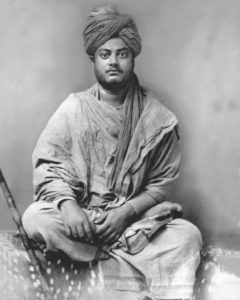 Subhas Chandra Bose believed that the Bhagavad Gita was a great source of inspiration for the struggle against the British. Swami Vivekananda’s teachings on universalism, his nationalist thoughts and his emphasis on social service and reform had all inspired Subhas Chandra Bose from his very young days. The fresh interpretation of the India’s ancient scriptures had appealed immensely to him. Many scholars believe that Hindu spirituality formed the essential part of his political and social thought throughout his adult life, although there was no sense of bigotry or orthodoxy in it. Subhas who called himself a socialist, believed that socialism in India owed its origins to Swami Vivekananda.
Subhas Chandra Bose believed that the Bhagavad Gita was a great source of inspiration for the struggle against the British. Swami Vivekananda’s teachings on universalism, his nationalist thoughts and his emphasis on social service and reform had all inspired Subhas Chandra Bose from his very young days. The fresh interpretation of the India’s ancient scriptures had appealed immensely to him. Many scholars believe that Hindu spirituality formed the essential part of his political and social thought throughout his adult life, although there was no sense of bigotry or orthodoxy in it. Subhas who called himself a socialist, believed that socialism in India owed its origins to Swami Vivekananda.
Not only Netaji but also almost every early nationalist was inspired by Swami Vivekananda, the foremost disciple of the Hindu mystic Sri Ramakrishna and helped by Sister Nivedita, disciple of the former. Born into an aristocratic Bengali family of Calcutta, Vivekananda was inclined towards spirituality. He was influenced by his guru, Ramakrishna, from whom he learnt that all living beings were an embodiment of the divine self; therefore, service to God could be rendered by service to humankind.
Ramakrishna’s religious practice and worldview contained elements of Bhakti, Tantra and Vedanta. Ramakrishna emphasised God-realisation, stating that “To realize God is the one goal in life.” Ramakrishna found that Hinduism, Christianity and Islam all move towards the same God or divine, though using different ways: “So many religions, so many paths to reach one and the same goal,” namely to experience God or Divine. Ramakrishna further said, “All scriptures – the Vedas, the Puranas, the Tantras – seek Him alone and no one else.”
After Ramakrishna’s death, Vivekananda toured the Indian subcontinent extensively and acquired first-hand knowledge of the conditions prevailing in British India. He later travelled to the United States, representing India at the 1893 Parliament of the World’s Religions. Vivekananda conducted hundreds of public and private lectures and classes, disseminating tenets of Hindu philosophy in the United States, England and Europe. In India, Vivekananda is regarded as a patriotic saint, and his birthday is celebrated as National Youth Day.
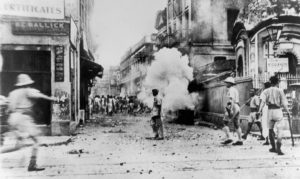
“With the spread of education and westernization, began the phase of ‘Renaissance’ in Bengal. Many social reform movements were carried out, and the growing intellectual population started understanding the meaning of freedom and the city became the centre of Indian Independence struggle. All the tensions led to the transfer of the capital of British India to Delhi. Even after the transfer, Kolkata remained a major hub for trade and independence struggle.” – concluded Sir Stuart.
“No one could have accumulated this better than you lad. You do love this city no doubt.” – said Captain Cooke. “Wait, till you hear the story of Indian independence and its aftermath in Calcutta. I have invited someone to join us at our way back to the cemetery. He also got very excited hearing about our little heritage walk around this city.” – said Sir Stuart.
“Who are you talking about?” – we all asked together.
“I think he is close enough to the gates. Let’s proceed that way.” – Sir Stuart said, and we all started following him towards the exit of the museum.
As soon as we reached outside, we saw a horse carriage rushing towards us piercing the midnight fog. Our eyes were wide open. Who can it be? Do we know him? Does he know any of us?

…To Be Continued

